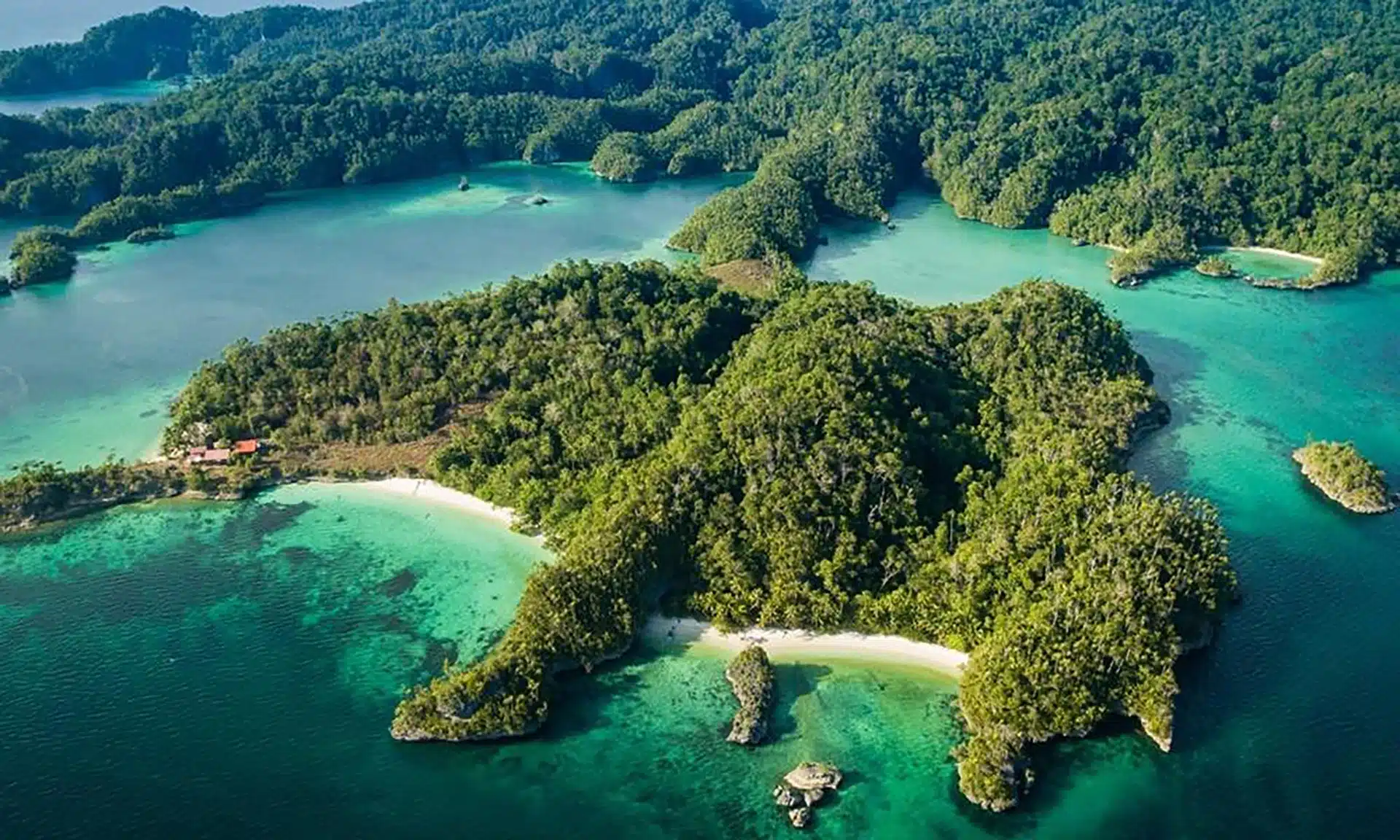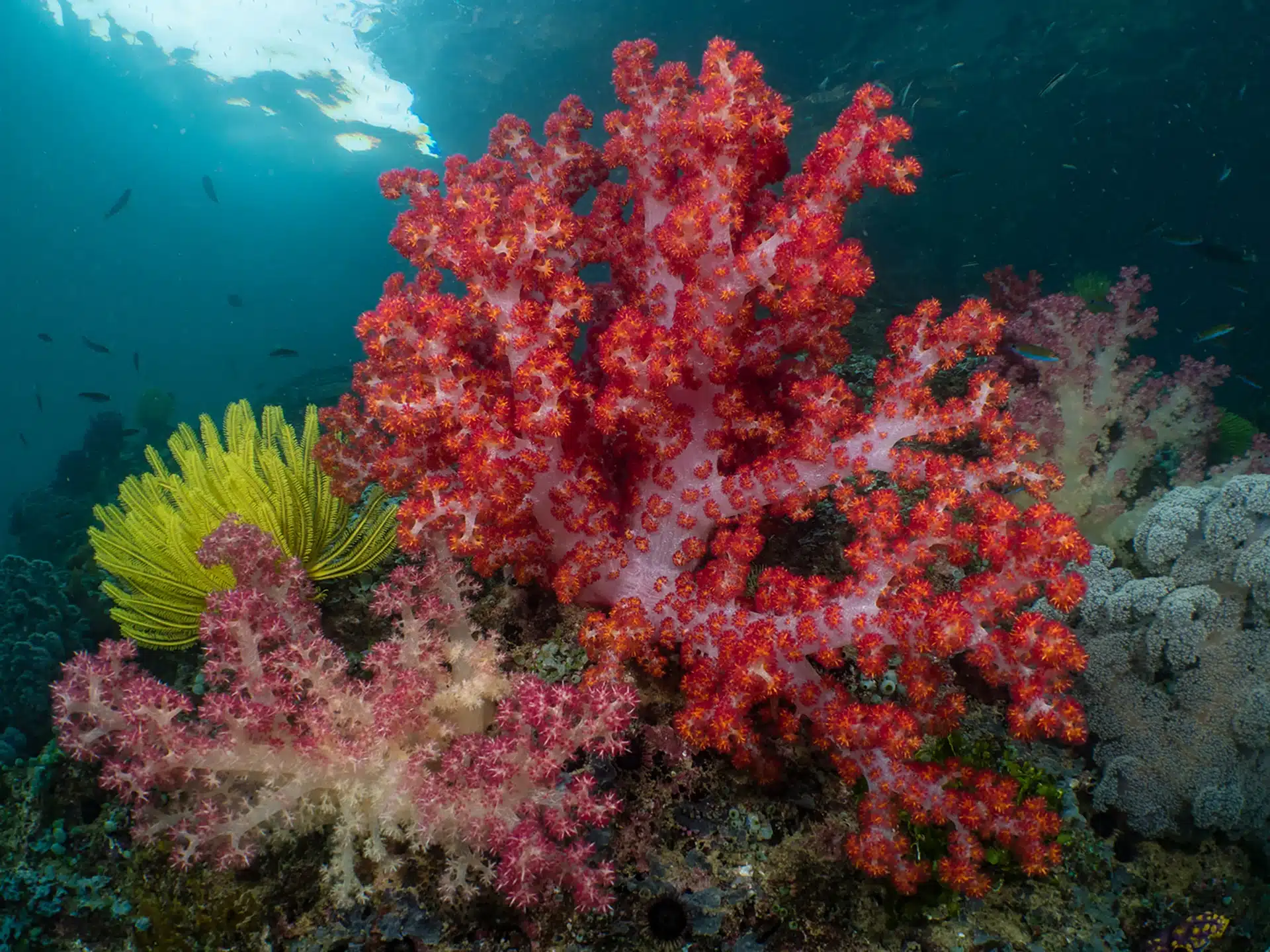Triton Bay is one of three regions that, together with Raja Ampat and Cenderawasih Bay, comprise the Bird’s Head Seascape of West Papua. The area has been protected since 2008, allowing fish stocks to recover from overfishing.
We can easily compare Triton Bay to Raja Ampat, interns of diversity and Biology. You will find similar topography and many species in common with the Raja Ampat archipelago. However, being located much further in the South, Triton Bay enjoys different currents and, therefore, a slightly different flux of nutrients. This gives the area an exceptional level of soft coral coverage. Triton Bay is famous for its black coral reefs and forests, that spread as far as the eye can see. A few liveaboards only visit this remote region, and you always get this fantastic spirit of being privileged and a pioneer when cruising in the area!
Devoid of humans, the healthy, pristine reefs are free of trash and human impacts. Excellent macro diving can also be found. All five species of pygmy seahorse can reliably be found – not only Denise and Bargibanti but also the tiny species of Pontohi and Satomi. The Paracheilinus nursalim flasher wrasse is found only in Triton Bay, Misool and South Raja Ampat.
Triton Bay is one of three regions that, together with Raja Ampat and Cenderawasih Bay, comprise the Bird’s Head Seascape of West Papua. The area has been protected since 2008, allowing fish stocks to recover from overfishing.
We can easily compare Triton Bay to Raja Ampat, interns of diversity and Biology. You will find similar topography and many species in common with the Raja Ampat archipelago.
Read More
However, being located much further in the South, Triton Bay enjoys different currents and, therefore, a slightly different flux of nutrients. This gives the area an exceptional level of soft coral coverage. Triton Bay is famous for its black coral reefs and forests, that spread as far as the eye can see. A few liveaboards only visit this remote region, and you always get this fantastic spirit of being privileged and a pioneer when cruising in the area!
Devoid of humans, the healthy, pristine reefs are free of trash and human impacts. Excellent macro diving can also be found. All five species of pygmy seahorse can reliably be found – not only Denise and Bargibanti but also the tiny species of Pontohi and Satomi. The Paracheilinus nursalim flasher wrasse is found only in Triton Bay, Misool and South Raja Ampat.
Triton Bay is a relatively remote area in the eastern region of the Indonesian archipelago. Its remote location means that marine biology has been left to flourish, making it an excellent location to explore and dive.
However, one of the main appeals of Triton Bay lies in the encounters with the beautiful Whale Sharks possible here.
The locals of Triton Bay use fishing platforms (called Bagans) that attract the Whale Sharks. They don’t just come and then disappear; they stay for prolonged periods – sometimes hours – which allows divers and swimmers to get a close-up experience with this majestic animal.
As we prefaced above, they are giant aquatic animals that can grow up to 20 meters long. Despite their large size, they are effectively harmless to humans because they are filter feeders – animals that feed strictly on plankton, krill, larvae, eggs and small crustaceans. Those not afraid of their large size can even swim up close to observe the sharks filtering the food from the water.
Triton Bay is also full of surprises on land. The vegetation is very wild given that the human impact is minimal, you can expect green landscapes and remote villages, where people live on their own miles away from modern civilisation. Even more impressive: some prehistoric paintings have been found on the cliff of Triton Bay and in caves of the surroundings.
The paintings represent some fishes, turtles, lizards, crocodiles, sea horses, snakes, and birds, among other symbols. This could be expressed by ancestors as a way to pass on other generations their lifestyle and perception of their home.
These ancient drawings are threatened by water damage, erosion, graffiti and the risk of cliff collapse but they are protected as part of the local heritage of Namatota Island.
These cruises pass trough the wonderful Misool. Currents from The Ceram Trough and Indonesian Throughflow provide nutrient-rich water, and the surrounding area is made up of the Pacific, Indian and Southern Oceans. All this and the remote location from development and pollution, ensure that the marine biodiversity is regarded by many, as the best in the world.
There are more than 50 excellent dive sites around the island, including many which can be reached from the shore but some of the better ones, submerged pinnacles and reefs, require a liveaboard for safe access.
The chain of small islands known as Fiabacet is located off the South East coast of Misool. At the southeastern tip of Misool’s archipelago is Warakaraket Island, home to Magic Mountain, and some of the best diving in all of Indonesia. Currents can be strong here, but they provide a regular source of food for the large pelagic species gathering here.
One of the more-photographed dive sites is ‘Boo Rock‘ on the east side of Misool. Here, in shallow water are ‘Boo Windows’ natural swim-throughs surrounded by coral and sea fans, that can be used for stunning photographic backdrops.
Farondi is also off to the east of Misool and offers plenty of great reefs, caverns and swim-throughs, with critters of all sizes, including the Pigmy Seahorse. Its main dive sites are ‘No Contest’, ‘Goa Besar’ & Verena’s Garden, amongst many others.
Misool is arguably the best place in the world to dive. There really is something for everyone at Misool. Although getting there is neither easy nor inexpensive, its remote location makes is so very special. It’s never crowded and doesn’t suffer from pollution or development.
Hightlights of Triton Bay Cruise:
- Diving with Whale Sharks
- Untouched healthy reefs with abundant fish life
- Beach BBQ
- Kayaking in pristine lagoons
- Kita Kita waterfall
- Diving in Misool
Dive Zones:
- Misool
- Pulau Pisang
- Triton Bay

GETTING HERE
Triton Bay is located approximately 30 nautical miles from the town of Kaimana in the Indonesian province of West Papua, previously known as Irian Jaya, on the western part of the island of New Guinea.
You can fly to Kaimana airport from Jakarta or Bali with 1 or 2 layovers. Another way to access Kaimana Bay is by joining the liveaboard from Sorong Harbour (Raja Ampat).

CLIMATE
The climate in Kaimana is hot, oppressive, and overcast. Over the course of the year, the temperature typically varies from 76°F (24 C) to 88°F (31 C) and is rarely below 75°F (23 C) or above 90°F (32 C).
The best time of year to visit Kaimana is from mid-June to mid-November.

DIVING
TEMPERATURE – The sea water temperature is averaging around 29°C throughout the yea. WETSUIT – 3 mm.
DIVING DEPTH – Max 35 m (100 Feet).
CURRENT – Some sites are subject to strong currents, but we always do our best to avoid diving in strong currents. However, on a number of sites on this cruise, a certain level of current is necessary to attract interesting fish activities.
VISIBILITY – Visibility in Triton Bay might change abruptly. Rarely exceeding 20 meters, it can lower to less than 10 meters, especially after a lot of rain in Triton Bay.

